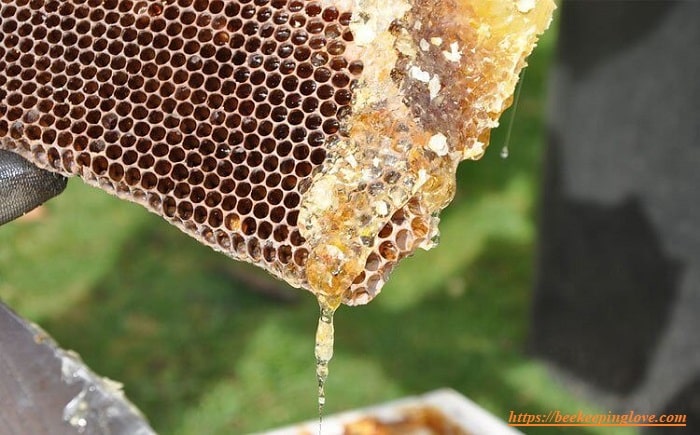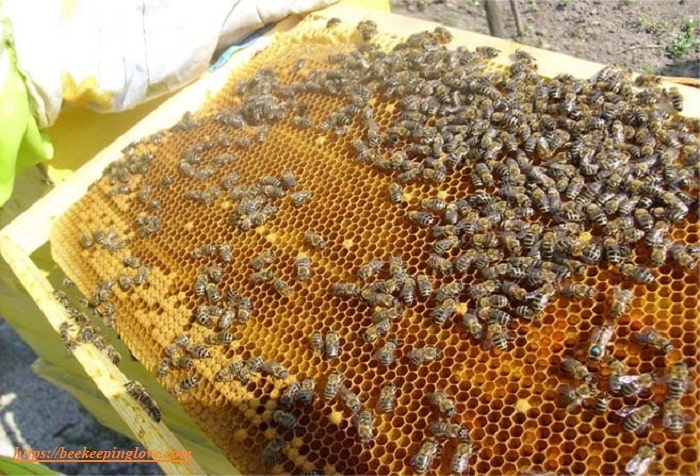Although beekeepers normally collect honey, they occasionally prefer to collect royal jelly. Because royal jelly is regarded to offer health benefits and has a high market demand and worth. Royal jelly is now a popular commercial product that is offered in many countries across the world. Harvesting royal jelly entails removing the cells, extracting the jelly, and carefully storing it. So, how to harvest royal jelly from bees?
How is Royal Jelly made?
Royal jelly differs from other products such as honey and propolis in that it is a milky-creamy white material released from the bodies of worker bees. Above the pharynx are the glands that make royal jelly.
Royal jelly is utilized to feed the larvae as well as the queen bees. All bee larvae are fed royal jelly during their first days of life. But only the larva that becomes the queen is fed royal jelly after this period has passed. The remaining larvae will be fed honey and pollen throughout the rest of their growth.

Why do bees require Royal Jelly?
The fact that royal jelly is high in nutrients is what distinguishes it. It causes the queen bee to grow twice as large as a worker bee. It also has a longer lifespan than other bees. The queen bee has a lifespan of 6 to 7 years, whereas the worker bee has a lifespan of 4 to 7 weeks, not years.
Royal jelly has an impact on the biological and physiological development of bees. A queen bee also relies on royal jelly to increase her fecundity. It benefits the reproductive system directly, making the queen bee the most productive insect. A single queen bee will lay 2000 eggs per day, allowing the bee colony to expand.
How to harvest Royal Jelly?
Working on the beehive necessitates the use of protective equipment. The basic protective clothing consists of a beekeeping suit, gloves, and a beekeeper’s veil. You should also cover your head. In addition, if the weather is hot, you should wear a ventilated suit to ensure maximum comfort. Royal jelly harvesting entails the following steps:
Removing the cells from the beehive
- Put on your safety equipment. Your beekeeper’s mask should be attached to your jacket so that there are no gaps between the collar and the hat’s brim. During hot weather, wear a ventilated beekeeper’s jacket or suit. This will assist you to be as comfortable as possible while tending to your bees.
- Wait until the larvae have reached the age of 3 days. This will result in the most royal jelly in your harvest. Remember that you can save the larvae and return them to the cells once the royal jelly has been extracted, so take care not to harm them.
- Remove one of the frames and sweep the bees away. Remove the frame containing the royal jelly cells and begin sweeping the bees that are clinging to it. To avoid disturbing the bees, move slowly and gently.
- Remove the frame from the beehive. It is best to bring the frame inside so that you can store the royal jelly that you extract and so that the bees do not return to the cells. At the very least, keep your distance from the bee hives.
Extracting the Royal Jelly
- Use a knife to cut the open narrow part of each of the cells. There is a narrow end on each of the cells that is holding the larvae and jelly inside. Keep the flat edge of the knife flush with the edge of the cell as you cut.
- Pull the larvae out of the cells using tweezers or small forceps. It is important to remove the larvae before you harvest the royal jelly. This will help to keep the jelly pure. Do not put the larvae into the same container as your royal jelly.
- Remove the remaining royal jelly from the cells with a small spatula. For very small amounts, you can also use a pipette to suck the jelly out of 1 cell at a time.
- Place the royal jelly into a glass storage container. If you are collecting a large amount of jelly at once, then you may want to put the container on ice to prevent it from spoiling. Royal jelly spoils within a couple of hours left unrefrigerated. So you may even want to collect smaller amounts at a time and place them into a refrigerator as you go.

Storing Royal Jelly
- It is important to protect the royal jelly from light, so transfer the jelly from your collection container to a dark glass container right away. Use a pipette or small spatula to do this. Screw the lid shut tightly. This will help to prolong the shelf life of the jelly.
- After you have transferred the jelly to dark glass containers, place them into a refrigerator between 0 to 5 °C (32 to 41 °F). This will protect the royal jelly from spoiling for up to 18 months.
- Storing royal jelly at −17 °C (1 °F) or lower will prolong the shelf life even longer. If you want to ensure that your royal jelly will be viable for up to 24 months, then put the vials into a freezer to store them. After the royal jelly has thawed, it should be stored in a refrigerator for no more than 12 months.
>>> Read more: How To Save Bees – Everything you should do
What is royal jelly good for?
Some of the benefits of royal jelly include the following: immune booster, boosts memory, improves the cardiovascular system, and promotes longevity. It also increases the number of red blood cells thus helps those with anemia. Royal jelly also helps common conditions such as skin disorders, high cholesterol, sleeping problems/insomnia, stomach ulcers, premenstrual syndrome, and pancreatitis.
Royal jelly is recommended for daily consumption just like any other regular foodstuff. It can be applied to bread or consumed directly. You can take as much of royal jelly as you like since it is a natural product without any side effects. However, one should take at least 300 to 6,000 milligrams of the product per day.
Pregnant women and those with underlying conditions should seek advice from their doctor before using royal jelly. You should also call your doctor if you experience any problem after taking royal jelly, for instance, diarrhea or stomach pain.
Is harvesting Royal Jelly cruel?
The process of harvesting royal jelly is never cruel. Selected colonies with movable frames are used specifically for producing queen bees. In most cases, the queen larva will be floating on the royal jelly inside the cell. It therefore, makes perfect sense to harvest the royal jelly from queen cells.
On average, a well-managed hive is capable of producing 500g of royal jelly. This usually requires proper storage since royal jelly spoils easily when exposed to moisture, light, or air. Royal jelly should be harvested with the environment in mind. The beekeeper should engage in bee-friendly practices since this helps foster social responsibility and transparency when handling honey bee products.
Conclusion
Royal jelly is an important honey bee product apart from honey, pollen, beeswax, and propolis. Sustainable ways of harvesting royal jelly are highly recommended, just like with the other beekeeping products. Remember the bees work so hard when secreting this special substance. If you needed to find out how to harvest royal jelly then we hope this article has been helpful.
